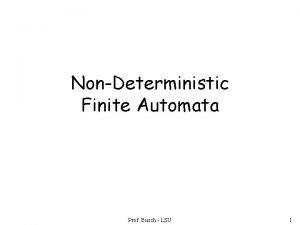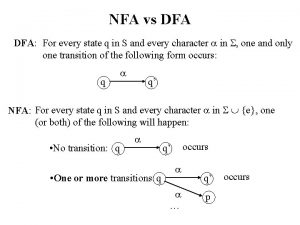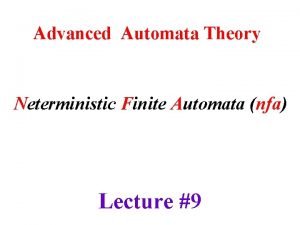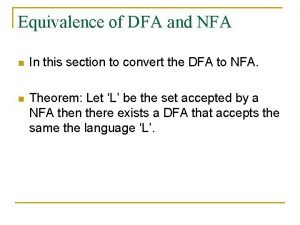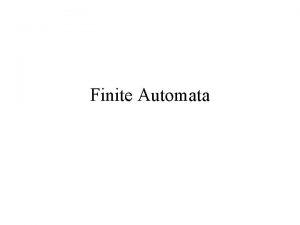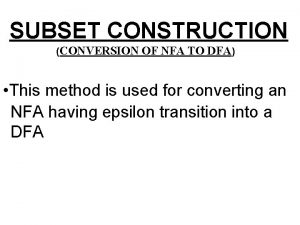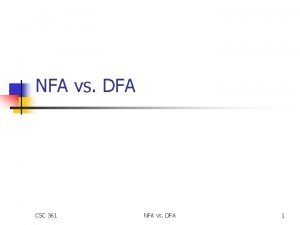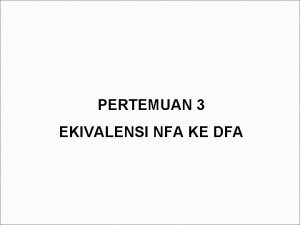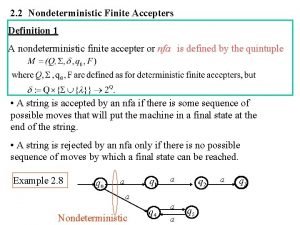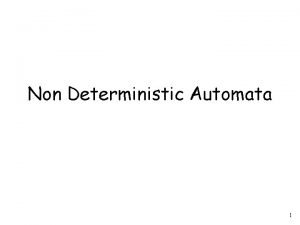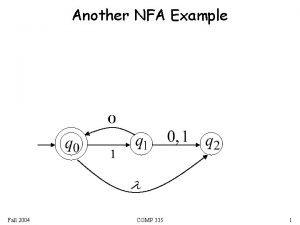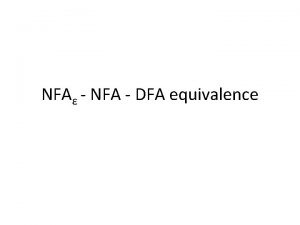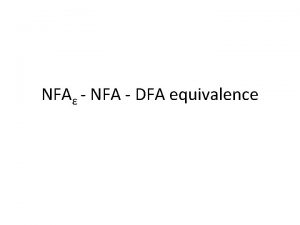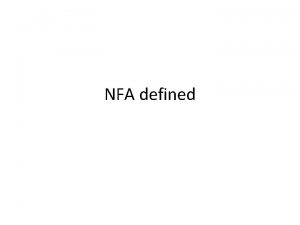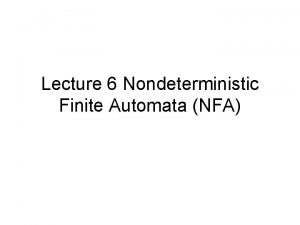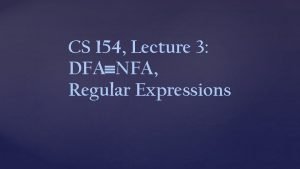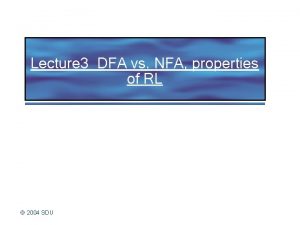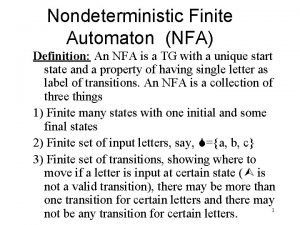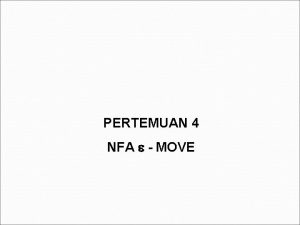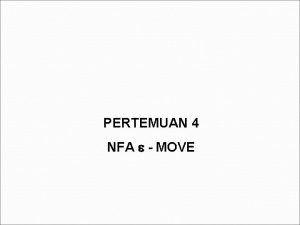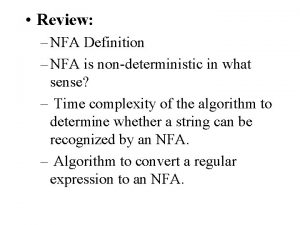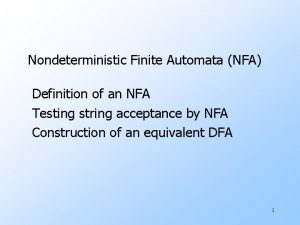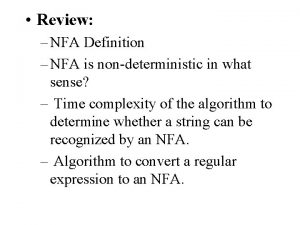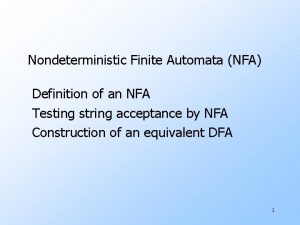Lecture 7 From NFA to DFA DFA For




![Construction of M’ Special Case: M has no ε-move. • [ε] = {s} • Construction of M’ Special Case: M has no ε-move. • [ε] = {s} •](https://slidetodoc.com/presentation_image_h/da5e2a1037c41d12736c7d5b5d31321b/image-5.jpg)
![From [x] to [xa] • [xa] = { p | there exists a path From [x] to [xa] • [xa] = { p | there exists a path](https://slidetodoc.com/presentation_image_h/da5e2a1037c41d12736c7d5b5d31321b/image-6.jpg)
![Construction of M’ • F’ = {[x] | x in L(M)} = {[x] | Construction of M’ • F’ = {[x] | x in L(M)} = {[x] |](https://slidetodoc.com/presentation_image_h/da5e2a1037c41d12736c7d5b5d31321b/image-7.jpg)






![From [x] to [xa] a • [xa] = { p | there exists a From [x] to [xa] a • [xa] = { p | there exists a](https://slidetodoc.com/presentation_image_h/da5e2a1037c41d12736c7d5b5d31321b/image-14.jpg)
![Construction of M’ • F’ = {[x] | x in L(M)} = {[x] | Construction of M’ • F’ = {[x] | x in L(M)} = {[x] |](https://slidetodoc.com/presentation_image_h/da5e2a1037c41d12736c7d5b5d31321b/image-15.jpg)



- Slides: 18

Lecture 7 From NFA to DFA

DFA • For every string x, there is a unique path from initial state and associated with x. x x is accepted if and only if this path ends at a final state.

NFA • For any string x, there may exist none or more than one path from initial state and associated with x.

NFA DFA • Consider an NFA M=(Q, Σ, δ, s, F). • For x in Σ*, define [x] = {q in Q | there exists a path s x • Define DFA M’=(Q’, Σ, δ’, s’, F’}: Q’ = { [x] | x in Σ* }, δ ([x], a) = [xa] for x in Σ* and a in Σ, s’ = [ε], F’ = { [x] | x in L(M) } q}
![Construction of M Special Case M has no εmove ε s Construction of M’ Special Case: M has no ε-move. • [ε] = {s} •](https://slidetodoc.com/presentation_image_h/da5e2a1037c41d12736c7d5b5d31321b/image-5.jpg)
Construction of M’ Special Case: M has no ε-move. • [ε] = {s} • Suppose [x] is known. How to get [xa] for a in Σ?
![From x to xa xa p there exists a path From [x] to [xa] • [xa] = { p | there exists a path](https://slidetodoc.com/presentation_image_h/da5e2a1037c41d12736c7d5b5d31321b/image-6.jpg)
From [x] to [xa] • [xa] = { p | there exists a path q some q in [x] } = { p | there exists q in [x], a q edgep } = U δ(q, a) q in [x] a p for path
![Construction of M F x x in LM x Construction of M’ • F’ = {[x] | x in L(M)} = {[x] |](https://slidetodoc.com/presentation_image_h/da5e2a1037c41d12736c7d5b5d31321b/image-7.jpg)
Construction of M’ • F’ = {[x] | x in L(M)} = {[x] | [x] ∩ F ≠ Ǿ }

Example 1 • Construct DFA to accept 00(0+1)* 0 s 0 0, 1 0 q p s 0 p 1 1 1 Ǿ 0, 1 0 q

Example 2 • Design DFA to accept (0+1)*11 0 s 0 1 1 s p q 0 s 0 1 1 1 p q

Example 3 • Design DFA to accept 00(0+1)*11 0 0 0 s Ǿ p q 0, 1 s 0 t r 1 1 1 0 p 0 1 q 0 q 1 r 0 r q t

Example 4 • Construct DFA M for L(M)=ε. Is this a DFA? s 0, 1 s 0 Ǿ 1

Example 5 • Construct DFA M for L(M)=Ǿ. Is it a DFA? s s 0 Ǿ 1 0, 1

Construction of M’ • For q in Q, define ε ε-closure(q) = {p | there exists a path q pathp} ε • [ε] = {q | there is a path s q} path = ε-closure(s) • Suppose [x] is known. How to get [xa] for a in Σ?
![From x to xa a xa p there exists a From [x] to [xa] a • [xa] = { p | there exists a](https://slidetodoc.com/presentation_image_h/da5e2a1037c41d12736c7d5b5d31321b/image-14.jpg)
From [x] to [xa] a • [xa] = { p | there exists a path q pathp for some q in [x] } = { p | there exists q in [x], a ε q edger pathp } = { p | for some q in [x] and r in δ(q, a), p in ε-closure(r) } = Uq in [x]U r in δ(q, a) ε-closure(r)
![Construction of M F x x in LM x Construction of M’ • F’ = {[x] | x in L(M)} = {[x] |](https://slidetodoc.com/presentation_image_h/da5e2a1037c41d12736c7d5b5d31321b/image-15.jpg)
Construction of M’ • F’ = {[x] | x in L(M)} = {[x] | [x] ∩ F ≠ Ǿ }

Example 6 • Construct DFA M for L(M)=(0+1)*. 0, 1 ε ε s p q 0, 1 s p q 0 1 p q 0, 1

Example 7 • Convert the following NFA to DFA. 0 s ε 0 p 1 0 q 1 ε ε 0 s r p r 1 0 q, r, p 1 q r s p 0 1 0

0, 1 s 0 0 a 1 0 0 b 1 c 1 0 d 1 e 1 s 0 s, a 1 s, b 1 s, c 1 s, d 1 s, e 0 s, a, b, c, d, e 5 How many states? 2 =32 4 How many final states? 2 = 16 Can we simplify it? No, it is minimum!
 Dfa and nfa
Dfa and nfa Nfa theory of computation
Nfa theory of computation Nfa to dfa
Nfa to dfa Dfa vs nfa
Dfa vs nfa Dfa to nfa
Dfa to nfa Dfa and nfa
Dfa and nfa Automata
Automata Subset construction method to convert nfa to dfa
Subset construction method to convert nfa to dfa Nfa to dfa subset construction method
Nfa to dfa subset construction method Nfa vs dfa
Nfa vs dfa Convert the following nfa to dfa:(upload)
Convert the following nfa to dfa:(upload) Transition diagram for relational operators
Transition diagram for relational operators Contoh soal ekuivalensi nfa ke dfa
Contoh soal ekuivalensi nfa ke dfa Dfa for (a/b)*abb
Dfa for (a/b)*abb Buatlah mesin dfa yang ekuivalen dengan mesin nfa
Buatlah mesin dfa yang ekuivalen dengan mesin nfa Nfa to dfa
Nfa to dfa Nfa dengan e-move
Nfa dengan e-move Nfa
Nfa Convert nfa to dfa
Convert nfa to dfa


